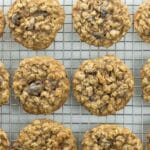Quaker Oatmeal Raisin Cookies
I'm all about developing new recipes and variations when the time is right. But sometimes there's no improving on a classic. Quaker oatmeal raisin cookies (also called vanishing oatmeal raisin cookies, and for good reason) are sheer perfection. Here's how to make them, with clearer directions and tips than the original.
Calories: 102kcal
Ingredients
- 14 tablespoons (196 grams) unsalted butter, at cool room temperature
- ¾ cup firmly packed (160 grams) light brown sugar
- ½ cup (100 grams) granulated sugar
- 2 large eggs
- 1 teaspoon pure vanilla extract
- 1 ½ cups (180 grams) all-purpose flour (see note 1 below)
- 1 teaspoon baking soda
- 1 teaspoon ground cinnamon
- ½ teaspoon fine sea salt
- 3 cups (240 grams) old-fashioned rolled oats
- 1 cup (160 grams) raisins
Instructions
- Preheat oven to 350°F with two racks close to the center.
- In a large mixing bowl or the bowl of a stand mixer fitted with the paddle, beat butter, brown sugar, and granulated sugar on medium speed until light and fluffy, two to three minutes.
- Add eggs and vanilla extract and beat until well-incorporated.
- Sift in flour, baking soda, cinnamon, and salt.
- Beat until incorporated.
- Add oats and raisins and stir in with a wooden spoon or spatula until evenly distributed. See note 3 below before proceeding.
- Using a medium (1 ½ tablespoon) cookie scoop or two spoons, drop by rounded tablespoonfuls onto ungreased cookie sheets, leaving plenty of space between them.
- Bake for 8 to 10 minutes, until just beginning to turn light golden brown, especially around the edges. They will still be very soft and pale in the center when you remove them from the oven and will set up to chewy deliciousness as they cool.
- Cool for two minutes on cookie sheets before carefully transferring to a wire rack to cool completely.
Notes
- As always when baking, it’s best to weigh your dry ingredients if you can. If not, make sure to measure your flour using the spoon and level method: give the flour a stir to lighten it up, spoon into your measuring cup, and then level it off with the back of a butter knife. The recipe calls for all-purpose flour, and that's what I typically use. To make the cookies chewier, you can substitute bread flour for some or all of the total quantity. The additional gluten in bread flour provides a bit more chew.
- Old-fashioned rolled oats are heartier than quick rolled oats and make a more robust cookie with a more varied texture. That's what I prefer. You can use quick oats if you'd rather. Do not use instant.
- It's not necessary to chill the dough before baking, but as with many cookie recipes, this one only improves with time in the fridge. In addition to spreading more evenly, chilled cookie dough browns better, produces a better depth of flavor, and improves texture. If you have time, chill your dough for at least 30 minutes and up to 24 hours before baking. If you've chilled for a longer period, it helps to let the dough warm up for 10 minutes or so before portioning.
- I tend to think that almost all cookies are at their very best shortly after baking, but these do hold up well for several days. Once completely cooled, you can store them in an airtight container at room temperature for up to about five days.
- To freeze some of the cookie dough for later, after portioning into heaping tablespoons, place the balls onto a parchment-lined baking sheet with a little bit of room in between. Freeze until solid, and then bag them by the dozen to gift or save for up to six months. Add one to two minutes to the cooking time when baking from frozen.
Variations and substitutions
- For a more nuanced spice profile, you can add ¼ teaspoon ground nutmeg along with the dry ingredients.
- You can substitute bittersweet or semi-sweet chocolate chips for the raisins.
- To either version, you can add one cup of chopped walnuts or pecans.
- To make oatmeal raisin bars, prepare the dough according to the instructions above. Press it into an ungreased 9x13x2-inch pan. Bake in the center of a 350°F oven for 30 to 35 minutes, until lightly browned on top. Place pan onto a cooling rack and let cool completely before cutting into bars. As with cookies, err on the side of a little bit less baking rather than a little bit more, so the bars will stay chewy and tender.
Nutrition
Serving: 1 | Calories: 102kcal | Carbohydrates: 11g | Protein: 2g | Fat: 6g | Saturated Fat: 3g | Polyunsaturated Fat: 2g | Cholesterol: 25mg | Sodium: 118mg | Fiber: 1g | Sugar: 4g
